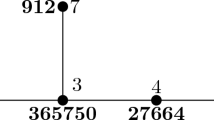Abstract
We continue our investigation into the insertion-elimination Lie algebra  of Feynman graphs in the ladder case, emphasizing the structure of this Lie algebra relevant for future applications in the study of Dyson–Schwinger equations. We work out the relation to the classical infinite dimensional Lie algebra
of Feynman graphs in the ladder case, emphasizing the structure of this Lie algebra relevant for future applications in the study of Dyson–Schwinger equations. We work out the relation to the classical infinite dimensional Lie algebra  and we determine the cohomology of
and we determine the cohomology of  .
.
Similar content being viewed by others
References
Alekseevsky, D., Michor, P.W., Ruppert, W.: Extension of Lie algebras. http://arxiv.org/list/math.DG/0005042, 2000
Bergbauer, C., Kreimer, D.: The Hopf algebra of rooted trees in Epstein-Glaser renormalization. To appear in Ann. Henri Poincaré, http://arxiv.org/list/hep-th/0403207, 2004
Broadhurst, D.J., Kreimer, D.: Exact solutions of Dyson-Schwinger equations for iterated one-loop integrals and propagator-coupling duality. Nucl. Phys. B 600, 403 (2001)
Connes, A., Kreimer, D.: Renormalization in quantum field theory and the Riemann Hilbert problem. I. The Hopf algebra structure of graphs and the main theorem. Commun. Math. Phys. 210(1), 249–273 (2000)
Connes, A., Kreimer, D.: Renormalization in quantum field theory and the Riemann Hilbert problem. II. The β-function, diffeomorphism and the renormalization group. Commun. Math. Phys. 216(1), 215–241 (2001)
Connes, A., Kreimer, D.: Insertion and Elimination: the doubly infinite Lie algebra of Feynmann graphs. Ann. Henri Poincare 3(3), 411–433 (2002)
Fuks, D.B.: The Cohomology of Inifinite Dimensional Lie Algebras., Contemporary Soviet Mathematics, New York: Consultant Bureau, 1986
Gross, D.: In: Methods in QFT, Les Houches 1975, Amsterdam: North Holland Publishing, 1976
Kreimer, D.: On the Hopf algebra structure of perturbative quantum field theory. Adv. Theor. Math. Phys. 2(2), 303–334 (1998)
Kreimer, D.: New mathematical structures in renormalizable quantum field theories. Annals Phys. 303, 179 (2003); [Erratum-ibid. 305, 79 (2003)], hep-th/0211136
Kreimer, D.: Factorization in quantum field theory: An exercise in Hopf algebras and local singularities. Les Houches Frontiers in Number Theory, Physics and Geometry, France, March 2003, hep-th/0306020
Kreimer, D.: The residues of quantum field theory: Numbers we should know. hep-th/0404090
Kreimer, D.: What is the trouble with Dyson-Schwinger equations?. Nucl.Phys. Proc. Suppl. 135, 238–242 (2004)
Mack, G., Todorov, I.T.: Conformal-Invariant Green Functions without Ultraviolet Divergences. Phy. Rev. D8, 1764 (1973)
Mencattini, I., Kreimer, D.: Insertion-Elimination Lie algebra: the Ladder case. Lett. Math. Phys. 64, (2004) 61–74
Nikolov, N.M., Stanev, Ya.S., Todorov, I.T.: Four Dimensional CFT Models with Rational Correlation Functions. J. Phys. A 35(12), 2985–3007 (2002)
Weibel, C.: Introduction to Homological Algebra. Cambridge Studies in Advanced Mathematics, 38. Cambridge University Press, Cambridge, 1994
Author information
Authors and Affiliations
Corresponding author
Additional information
Communicated by Y. Kawahigashi
D.K. supported by CNRS; both authors supported in parts by NSF grant DMS-0401262, Ctr. Math. Phys. at Boston Univ.; BUCMP/04-06.
Rights and permissions
About this article
Cite this article
Mencattini, I., Kreimer, D. The Structure of the Ladder Insertion-Elimination Lie Algebra. Commun. Math. Phys. 259, 413–432 (2005). https://doi.org/10.1007/s00220-005-1340-7
Received:
Accepted:
Published:
Issue Date:
DOI: https://doi.org/10.1007/s00220-005-1340-7



